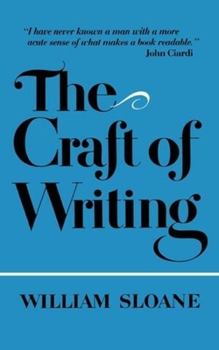The Craft of Writing
Select Format
Select Condition 
Book Overview
William Sloane was a brilliant editor, publisher, and teacher for more than forty years. In this book are gathered chapters derived largely from lectures he gave over twenty-five years at the Bread Loaf Writers' Conference, from correspondence with writers, and from editorial memoranda dealing with the specifics of a writer's problems.
Format:Paperback
Language:English
ISBN:0393300501
ISBN13:9780393300505
Release Date:June 1983
Publisher:W. W. Norton & Company
Length:128 Pages
Weight:0.20 lbs.
Dimensions:0.3" x 4.9" x 7.4"
Customer Reviews
2 ratings
Interesting. Valid points that should be considered when writing.
Published by Thriftbooks.com User , 19 years ago
Many people might think Sloane to be kinda harsh, but, reality hurts. In order to express your creative juices, you must first master the technique. Some people might say it hinders the creative process, and these people,I believe, just write fiction without a sense of art. Art is not just, in my opinion, not just the ability to create something interesting, but making it appealing and correct (the craft) is also essential. How are you gonna express yourself if what you are writing is not readable or does not please the reader in all the dimensions that make a piece of writing readable? I recommend this book to many writers accross the internet, who believe that having a nice story is everything, yet I cannot (most of the time) get past the first two parragraphs. Even if you think he is a tough cookie, Sloane must be read. In order to achieve synthesis, you must look at both sides, even if you don't agree with one (which is not the case with me). Sloane is not really abstract in this book as some may say. Others are really abstract, talking about emotions and feelings and not giving concrete examples of what they mean. I think anyone interested in making the art of fiction his/her career should at least read the first few chapters.
Complex and abstract, but worth the effort
Published by Thriftbooks.com User , 25 years ago
If you're a serious writer, read, understand and follow the precepts in this book. True, Sloane--a career editor--is terse and abstract, but he speaks with such enormous authority and conviction, _The Craft of Writing_ is in my top four how-to writing books, next to Strunk and White. For example, Sloane emphasizes why the reader reads anything: "tell me about me." He urges, make the "reader not a spectator, but a participant." "Action," he goes on, is the "plot," while "reaction" is [reader] emotion. Though most grammar school graduates eschew the "theme" word, Sloan says it's integral and inseparable to all successful novels, as each word, sentence and paragraph must support the core argument of the work. I got the most out of the dialogue chapter. Every instance of dialogue must fulfill at least two of the following functions: characterization, setting, tell the backstory or theme. That's as close as Sloan ever gets to a writing cookbook.






